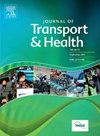Comparing pedestrian and cyclist injuries from falls and collisions in British Columbia, Canada: Frequencies and population characteristics
IF 3.2
3区 工程技术
Q2 PUBLIC, ENVIRONMENTAL & OCCUPATIONAL HEALTH
引用次数: 0
Abstract
Introduction
Walking and cycling offer health benefits but carry injury risks. Traditional road safety datasets often exclude pedestrian and cyclist falls, despite emerging evidence that injuries from falls occur more frequently than collisions with motor vehicles.
Methods
This research compared the frequency of pedestrian and cyclist injuries from falls versus collisions using hospital admissions data from a linked database of road traffic injuries in British Columbia, Canada, which combined hospital admissions, and sociodemographic information from 2015 to 2019. Additionally, we examined differences in injury severity and population characteristics between those injured in falls versus collisions.
Results
Of 6807 pedestrian hospital admissions, 68.8 % were from falls—2.3 times higher than motor vehicle collisions (29.2 %). Among 2409 cyclist admissions, falls accounted for 48.6 %–1.8 times higher than motor vehicle collisions (27.6 %). More severe injuries (MAIS3+) occurred less frequently in falls (25.0 % pedestrians, 17.9 % cyclists) than in collisions with motor vehicles (39.7 %, 27.4 %). We also found that falls disproportionately happen to older adults, females, higher-income individuals, and rural residents with more pronounced differences in pedestrians.
Conclusions
Our analysis revealed that pedestrian and cyclist falls are major contributors to the burden of road traffic injury and emphasizes the need for their inclusion in road safety surveillance and research. Reliance on datasets that exclude falls, or failing to consider falls as a road safety issue, can potentially hinder the development of infrastructure and built environment design solutions aimed at reducing the frequency and severity of fall injuries to pedestrians and cyclists.

比较加拿大不列颠哥伦比亚省行人和骑自行车者的跌倒和碰撞伤害:频率和人口特征
引言 步行和骑自行车有益健康,但也有受伤的风险。传统的道路安全数据集通常不包括行人和骑自行车者摔倒的情况,尽管有新的证据表明,摔倒造成的伤害比与机动车碰撞造成的伤害发生得更频繁。方法这项研究利用加拿大不列颠哥伦比亚省道路交通伤害链接数据库中的入院数据,结合 2015 年至 2019 年的入院情况和社会人口信息,比较了行人和骑自行车者因摔倒和碰撞受伤的频率。此外,我们还研究了摔伤与碰撞受伤者在受伤严重程度和人群特征方面的差异。结果 在 6807 名入院的行人中,68.8% 是摔伤,是机动车碰撞(29.2%)的 2.3 倍。在入院的 2409 名骑车者中,跌倒伤占 48.6%,是机动车碰撞伤(27.6%)的 1.8 倍。与机动车碰撞(39.7%,27.4%)相比,跌倒(25.0% 行人,17.9% 骑自行车的人)造成的更严重伤害(MAIS3+)发生率较低。我们还发现,跌倒主要发生在老年人、女性、高收入人群和农村居民身上,而行人的差异更为明显。结论我们的分析表明,行人和骑自行车者跌倒是造成道路交通伤害的主要原因,并强调有必要将其纳入道路安全监测和研究中。依赖不包括跌倒的数据集,或不将跌倒视为道路安全问题,可能会阻碍旨在降低行人和骑自行车者跌倒受伤的频率和严重程度的基础设施和建筑环境设计解决方案的开发。
本文章由计算机程序翻译,如有差异,请以英文原文为准。
求助全文
约1分钟内获得全文
求助全文

 求助内容:
求助内容: 应助结果提醒方式:
应助结果提醒方式:


